|
FAQs about Non-Vertebrate Animal Identification
43
Related Articles: Marine Invertebrates, Marine Invertebrate Systems, Marine Invertebrate Compatibility,
Marine Invertebrate Disease,
Marine Invertebrate
Reproduction, Quarantine of Corals and
Invertebrates, Feeding
Reef Invertebrates, Lighting
Marine Invertebrates, Water Flow, How Much
is Enough,
Related FAQs: Non-Vert IDs 1, Non-Vert IDs 2, Non-Vert IDs 3, Non-Vert IDs 4, Non-Vert IDs 5, Non-Vert IDs 6, Non-Vert IDs 7, Non-Vert IDs 8, Non-Vert IDs 9, Non-Vert IDs 10, Non-Vert IDs 11, Non-Vert IDs 12, Non-Vert IDs 13, Non-Vert IDs 14, Non-Vert IDs 15, Non-Vert IDs 16, Non-Vert IDs 17, Non-Vert IDs 18, Non-Vert. ID 19, Non-Vert. ID 20, Non-Vert. ID 21, Non-Vert. ID 22, Non-Vert. ID 23, Non-Vert. ID 25, Non-Vert ID 26, Non-Vert ID 27, Non-Vert ID 28, Non-Vert ID 29, Non-Vert ID 30, Non-Vert ID 31, Non-Vert ID 32, Non-Vert 33, Non-Vert ID 34 Non-Vert ID 35, Non-Vert ID 36, Non-Vert ID 37, Non-Vert ID 38, Non-Vert ID 39, Non-Vert ID 40, Non-Vert ID 41, Non-Vert ID 42, Non-Vert ID 44, Non-Vert ID 45, Non-Vert ID 46, Non-Vert ID 47, Non-Vert ID 48, Non-Vert ID 49, Non-Vert ID 50, Non-Vert ID 51, Non-Vert ID 52, Non-Vert ID 53, Non-Vert ID 54, Non-Vert ID 55, Non-Vert ID 56,
Non-Vert ID
57, Non-Vert ID 58,
Non-Vert ID 59,
Non-Vert ID 60, Non-Vert ID 61,
& Marine Invertebrates, Marine Invert.s 2, Marine Invert.s 3, & FAQs about:
Marine Invertebrate Behavior,
Marine Invertebrate
Compatibility, Marine
Invertebrate Selection, Marine
Invertebrate Systems, Feeding
Reef Invertebrates, Marine
Invertebrate Disease, Marine
Invertebrate Reproduction, &
& LR
Life Identification, LR Hitchhiker ID
1, Anemone Identification,
Aiptasia
Identification, Aiptasia ID 2,
Worm Identification, Tubeworm ID, Polychaete Identification, Snail Identification, Marine Crab
Identification, Marine Invert.s 1,
Marine Invert.s 2, Marine Plankton,
|
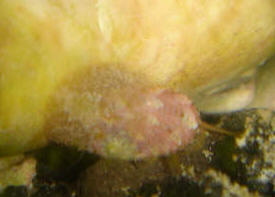
|
Help with identification of corals & fish, help yourself
1/31/09
Can you help with the identification of the corals & fish
attached.
Common names are sufficient.
<Hmmm, this is some fairly common, simple stuff. A little research
on the net or the purchase of a book or two will help you ID these and
more. Check http://wetwebmedia.com/swbooksneale.htm for some
recommended books.>
Thank you.
<Welcome, Scott V.>
Re: Help with identification of corals & fish
2/1/09
My apologies to be a bother. You web site came highly recommended by
the local aquarium group here.
I have bought several books and have been pouring thru pictures at the
library.
Your e-mail was rather rude and short. Please do not respond.
Thank you.
<Ooh, ooh, can I answer this one! Seriously, Wheeler, as Shakespeare
would say, the fault was not in the stars. Your e-mail had twenty
photographs attached. It wasn't sent in a particularly informative
or polite way, but more like what happens when your boss
"asks" you to do something. It was a demand for a bunch of
work without explaining why we at WWM should care. For what it's
worth, I did actually look through a few of those images; I saw what
seemed to be a blue-spotted grouper, a titan trigger, an Arothron
puffer of some sort, a cuttlefish or two. I make the point that I could
have a stab at naming them, and I'm the guy who helps with the
*freshwater* fish queries. What I know about marine aquaria you could
write on the back of a postage stamp! None of us a paid to do this, so
we tend to expend more energy on those e-mails that are engaging or
urgent. If we get anything that comes across as a curt demand for
information, then as Bob F. likes to say, "No Sale". Have a
nice day, Neale.> <<Thank you Neale. RMF>>
|
I.D. Please; Featherduster 1/29/09
Hi guys,
<Hello>
I appreciate your service very much as it has been very useful. I
am very green when it comes to saltwater aquatics. I have sent a
pic to hope that someone my identify this little creature. They
are white, round and feathery like.
<Looks like a small feather duster, a harmless filter
feeder.>
I have 3 little ones as pictured they are about the size of a BB
and I have a larger one about the size of a quarter. I would have
loved to get a picture of the larger one, but, it's in a
crevasse and not able to get any pictures. My tank is a 55g and
is about 6 months old. Thank-you.
<Please compare them to http://www.wetwebmedia.com/feather.htm
and the linked FAQs on ID. Also, compare them and the larger ones
to
http://www.wetwebmedia.com/marine/inverts/cnidaria/anthozoa/aiptasia/aiptasia.htm
and the linked FAQs on ID. Sometimes they are apparently thought
to be the same. I do wish you much fun with your hobby. Cheers,
Marco.>
|
 Mmm, looks like an Octocoral/"Polyp" to
RMF. Mmm, looks like an Octocoral/"Polyp" to
RMF.
R e: I.D. Please --
1/30/09
"Mmm, looks like an Octocoral/"Polyp" to
RMF."
<Yes, I also saw that there are 8 tentacles, but solitary
Octocorals are quite uncommon, limited to 3 or so genera from
deep waters like Taiaroa sp.
There are small feather dusters like Brachiomma curta that have
relatively few arms (about 12), Spirorbis sp. has 9. What do you
think? ...a better picture would reveal more detail.
Marco.>
<Mmm, do agree with you all the way around... but thought
I'd toss in my dos centavos re the Cnid. poss. Danke,
BobF>
|
|
Egg cup like things 1/26/09
Hey Crew,
<Danny>
I just noticed these white cup shaped "things" in my
sump / refuge. They are about an 1/8" by 1/4" long and
are attached by a stem. In the sump I have a tiger cowry and a
red footed snail (species unknown), do you think
these could be eggs from either?
<Mmm, possibly the latter>
I hope you could let me know what they are and if I should remove
them or not.
<I would leave these be... do look like solitary (i.e.
non-colonial)
Ascidians most likely... sea squirts... not harmful... Actually
beneficial and interesting>
Thanks in advance for any information you can provide,
Danny
<Please read here: http://wetwebmedia.com/ascidians.htm
and the linked files above. Bob Fenner>
|
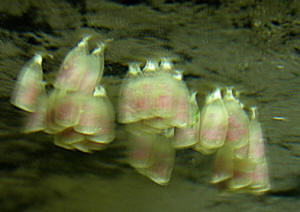 |
|
What IS this creature in my reef?
01/23/09
Hi Bob and crew!
Hope you are all doing well, it's been a while since I've
written!
There are all kinds of baby creatures popping up in my 7-year-old
55 gal. reef tank lately. Among the dozens of newborn Astrea
snails, I found this little wonder (see pics which show it from
both the top and bottom).
<It's an Asterina starfish... quite common.>
My first guess was a starfish of some kind (since about a year
ago I did have a couple brittle stars in the tank, and have
gotten some new corals a few months ago, so probably a
hitchhiker). I thought it resembled a chocolate chip star (which
I have never had). But I am really questioning whether it is a
star because this little creature actually has 7 legs.
<And how many legs do you think a starfish should have? There
are some with a few dozen...>
(OMG! Could it be an octopus missing a leg?!)
<...>
My second guess was some type of coral or anemone?
<Please stop guessing... it's a starfish, trust
me.>
But it looks like there is a mouth on the bottom. I would be very
interested in your opinion. Do you know what this is?? I am
hoping it is a good creature. If it is not good, will it eat my
corals or snails?
<Nope. They are grazers... mostly harmless. Some people are
weary of them when they get to be really numerous. But in my
experience, there is no cause to be. In fact, they are often sold
as algae eaters/scavengers.
Personally, I like them.>
Here are the photos I took. Please feel free to use them and/or
resize them as you'd like for your web site.
Thanks so much for your help!
Laura
<De nada,
Sara M.>
http://www.olaura.com/reef/creature-top.jpg
http://www.olaura.com/reef/creature-bottom.jpg
|
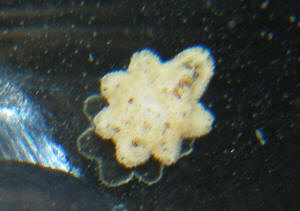 |
|
What Are They? Stomatellid Snail and
Possible Pseudocorynactis -- 1/20/09
<Hi Nancy, Lynn
here this morning.> Could you identify these creatures for
me?? <I'll sure try!> My LFS told me you would be a
better source than them to make a correct ID. The first one is
incredibly small - maybe a few millimeters wide. I have 3 of them
on my live rock. The biggest one is the one in the first pic. It
does eat small pieces of mashed shrimp when it is dragged over
it. Its sticky tentacles grab right on, and it bubbles up to
swallow it. <Hmmm, that is one tiny creature, isn't it! I
can't quite see enough detail to be sure, but it looks a lot
like a harmless Corallimorph in the genus Pseudocorynactis.
Please see the FAQ's/photos at the following link for more
information and comparison:
http://www.wetwebmedia.com/mushridf4.htm > The second creature
I found today and thought while sending you the first pic, that
I'd send you one of this at the same time. <Bring it
on!> It looks like maybe a Nudibranch?? <No, but
they're often (and understandably) mistaken for that or a
limpet.> Maybe it's a baby snail? <Bingo! It's a
harmless and very beneficial snail in the genus Stomatella --
likely Stomatella varia. They're herbivorous grazers that are
highly variable in color, reproduce readily in our tanks, and can
get up to ~1.25' in length.> Doesn't look like it has
much of a shell if it is. <You're right. The shell is very
small indeed but typical of this genus.> It does suck and have
antenna like a snail, but its body is very long (about a
centimeter). Hopefully these are a great bonus to my new
mini-reef, and not bad ones!! <They are indeed a great bonus!
For more information/photos, please see the following links:
http://wetwebmedia.com/MolluscPIX/Gastropods/Prosobranch%20PIX/Limpets%20Scutus/LimpetF1.htm
http://bb.wetwebmedia.com/viewtopic.php?f=25&t=181 >
Thanks so much for your help!!! Nancy <You're very
welcome, Nancy! Take care, Lynn>
|
 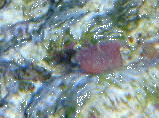 |
|
Maybe a sponge?
01/18/09
Hello, I saw this thing growing in my 55gal reef tank about a
month ago.
Appears to be some kind of sponge, but I was hoping to get an
opinion. It's light gray and has a soft/spongy texture. Has a
very strange pattern and a distinct hole in the middle of it.
It's about the size of a nickel. Any ideas?
<If there's only one main hole, yes, I'd say it's
likely a sponge. If there are two holes, then it might be a
tunicate.>
Thanks so much,
Tiffany
<De nada,
Sara M.>
|
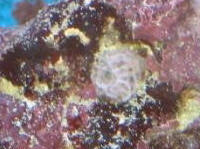 |
I still am of the opinion that we could/should produce di-,
tri-chotomous keys... with drawings 1/16/08
... I can/will
pay Dorkasaurus, others to produce... and neat-o guides like those on
Melev's Reef (.com)<
I totally agree. If there's anything I can do to help, please let
me know. What's even better is that this is a slow time of year for
me, so I'm relatively free for the next couple of months.
<How should we proceed? I recently saw Ron Shimek's go... not
all that useful>
<<I agree. I think we could come up with something more
user-friendly. People need pictures/drawings along with a key,
otherwise they get overwhelmed with unfamiliar descriptive terms and
give up. It's the old adage "A picture's worth a thousand
words".
I've always wanted to do an interactive key, but I'm guessing
that's got to require some kind of program (it's awful being
such a computer dummy). It would be great though, because people like
anything interactive these days. You could start off with the basic
list of criteria presented as clickable buttons (with pictures/drawings
where necessary), then keep getting more and more specific, down to
species in many cases. You could also have direct links for those
people that already know they have some type of snail or sea slug but
want to narrow it down further. At some point in their search (maybe
Family level?), there would be a drop down menu listing
locales/location of origin choices for the organism (including
"Unknown"). From there, they'd just keep narrowing things
down until they could go no further.
The great thing is that this project could be presented with the
basics, initially, and still be very useful for hobbyists. Beyond that,
it would be a continuing work in progress. You could have those
members/others that specialize in certain areas, contribute their own
section(s) of flow charts/keys (obviously subject to your
review/approval) that take the inquirer as far as the contributor is
able - in some cases, to species level.
This would be a huge undertaking as a whole, but seen as segments,
really isn't too awful. I just think it would be a terrific tool
for people and a great addition to WWM. I don't know of anything
else like it out there for hobbyists. It would be user-friendly,
include pictures, and better yet, we'd be able to offer more
in-depth information on the various organisms right there at WWM. All
we'd have to do is list them at the top of each page - like we
already do. It's a win-win as I see it!>>
Interestingly enough, the day after Christmas, I decided to start
putting together a thread at the forums that would serve as a quick
visual ID guide for hitchhikers. To that end, I've been sorting and
going through what photos I have and trying to outline how to best
present it. The thing is though, if we could pool our resources and
talent, and put something together through WWM, for WWM, it would be
much better all the way around. Just give me a shout if I can be of any
assistance - I'd love to be a part of that project.
<When I'm back in SD... next week... actually the weekend ending
the 24th, I'll pen the beginning, a start... and ask others to
chime in...>
<<Sounds great!>>
Take care. Oh, and by the way, if you're home in San Diego right
now, please send us some sun!! We've had "pea soup" fog
now for 3 days and I'm tired of it!
-Lynn
<Am out in HI... it is also fab here currently. Take care, B>
<<Oh lucky you! It's cold pea-soup again here today, but
I'm hoping for the best for this weekend. Take care and have a
great weekend - Lynn>
>Yikes... well, sis Donna is down taking diving lessons... Me, got
to pull more weeds, do some other house moving prep. work today...
Cheers! BobF<
Please Help with what ever these things are
in our SW tank
Worm ID 1/15/09
Hi Bob,
<Hi Shirley, you drew James today.>
Hope you are able to help.
<I'll try.>
In our 55 gallon Saltwater tank we have these hard tubular things
growing on the rock, and even on snails. It has this white stringy
stuff that comes out of them. If you know what these could be could you
please let me know and let me know if I should worry about them.
<These are very likely a species of Polychaete worm from the Family
Serpulidae. They are detritivores and are harmless.>
Thank you,
<You're welcome. James (Salty Dog)>
Shirley
|
Id of hitchhiker 1/3/09
I have been keeping saltwater tank's for almost four years
now. After I started I found this great site. Any problems have
been taking care of thanks to you. My tank's are 75 gals reef
, 55 gal seahorse , 5 gal dwarf seahorse . All test show 0 except
for nitrates that are about 20 . I found this about two years ago
.It was so small that I had to use a magnify glass to see what it
looked like .It is now about 1inch long the half shell on top
that is . I have looked at slugs ,snails , and anything else I
could think of but could not find . Thank you and happy new
year.
<Looks like a juvenile Haliotis sp. gastropod of some sort,
the sea snails commonly called "abalones" or
"ear-shells". What you should see is that the shell is
flat like a dish but coils over to one side when viewed from
above, and on the side away from the coil you'll see a row of
small openings running from the helix all the way to the front of
the shell. Your photo is of the side with the coil, so I
can't see those openings. Adult Haliotis spp. at least are
almost entirely herbivorous, feeding on different types of green
and red algae. Since yours is growing and is unlikely to be doing
any harm to your other marine life, I think you can sit back and
enjoy this rather fascinating snail. For more, see here:
http://www.wetwebmedia.com/abalones.htm
Cheers, Neale.>
<<Mmm, is a Trochid... that looks like, is most often
listed as a limpet... likely of the genus Stomatella. Please read
here:
http://wetwebmedia.com/MolluscPIX/Gastropods/Prosobranch%20PIX/Limpets%20Scutus/LimpetF1.htm
BobF>>
|
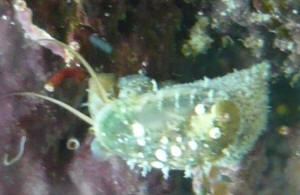 |
|
More re: Id of hitchhiker
1/3/09
Hi Bob. You may well be correct. The shell looked distinctly
asymmetrical to me, hence plumping for Haliotis. I wasn't
aware that there were any flat shelled Trochids, but Stomatella
does indeed appear to be one such beast.
Obviously a view from the side away from the spiral would have
show (or not) the gill openings, and clinched the deal! Cheers,
Neale.>
"<<Mmm, is a Trochid... that looks like, is most often
listed as a limpet... likely of the genus Stomatella. Please read
here:
http://wetwebmedia.com/MolluscPIX/Gastropods/Prosobranch%20PIX/Limpets%20Scutus/LimpetF1.htm
BobF>>"
<Another point of divergence, asking if you will... For so
many organisms, groups we deal with... the use of the more
"common" names and higher tax. for findings sake...
Here, should I/we put Stomatella "in" with the
Trochidae, or place (as I have) with the Limpets... as they are
commonly "found" in hobby lit.? B>
Re: More re: Id of hitchhiker
1/3/09
Thank you for the id . I first thought it was an Abalone but as
it did not have holes along the side . I never thought to look at
Limpets cause I only heard of keyhole limpets . As this did not
have a hole on top . After looking over your Limpets page and
doing a Google search on them . I do have a Limpet .
thanks for everything and this great site .
<Mmm, again... this is actually a Snail... a member of the
family Trochidae... Is called a limpet due to its flattened
appearance I guess.
Cheers! BobF>
|
|
|

